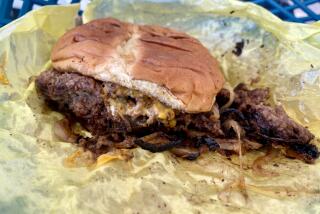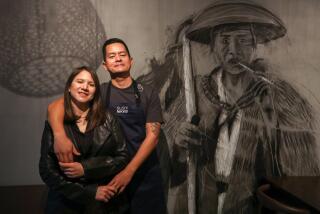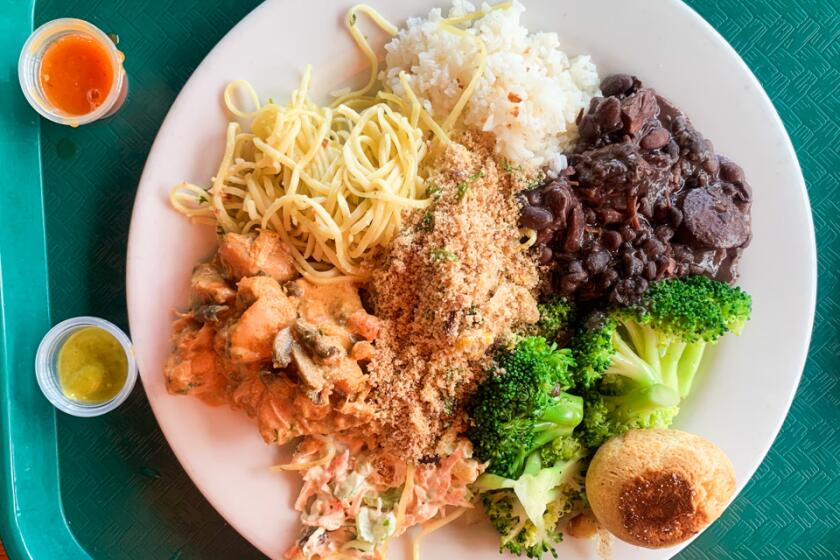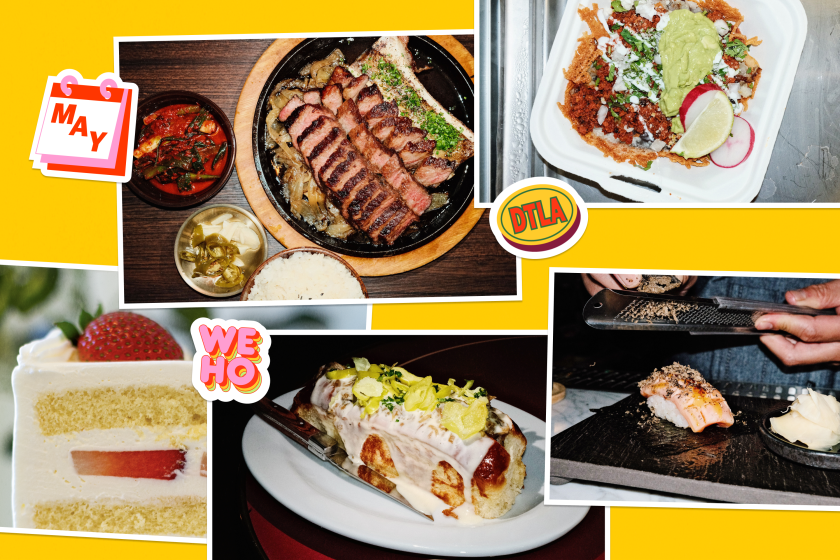Praise the Lard : Everything but the Squeal
At one time I had a close relationship with lard.
It started when I was working my way through graduate school at the University of Iowa by waitressing at the Hawkeye Truck Stop in nearby Coralville. One Sunday, I got an invitation from one of the drive boys at the truck stop to visit some of his family, who lived way out in the country. Drive boys fuel the big trucks, wash windows and, if I recall correctly, thump those 18 tires with clubs.
This drive boy was actually a fully grown white-haired man named Donny, who had taken a fatherly liking to me. I don’t remember the exact reason for this invitation--I might have complained that I’d lived in Iowa for some time and had never been on a farm--but I do remember the outcome of the visit: I came home with a piglet, a little male shoat I promptly named Joey.
We put Joey in the dog kennel for a few nights, while my boyfriend at the time, Alan, built him a true hog pen in the barn. Joey had red bristles with a white collar that formed a jaunty chevron behind his ears. He was an affable, sporty young pig and I made a pet of him. I was a city girl, and besides, befriending pigs was something of a family tradition. My mother had grown up on a farm in Delaware, and I grew up hearing about her pet pig, Wallis Warfield Windsor Blechman.
I had always wanted a pig of my own. I taught Joey how to sit and shake hands and roll over. He also liked to have his back scratched with a rake. I believe he would have done just about anything for a scrap of food.
We fed him pig chow and scraps I collected at the truck stop. He ate everything--leftover crusts of hamburgers, hash browns, bits of egg and, yes, the remains of pork tenderloin sandwiches and bits of bacon. Joey wasn’t particular. He was just hungry. He was a pig. He ate wilted lettuce clotted with Thousand Island dressing, potato parings, flapjacks and chicken-fried steaks. But mostly, he ate chop suey rolls.
Chop suey rolls were these enormous, dark, loathsome fritters that came each day with the doughnuts. They were crisp and greasy from deep-frying and thickly glazed with white icing, with swirls of cinnamon and candied fruit in them. Not even the burliest trucker could eat an entire chop suey roll, and few people were tempted to even eat a part of one, so at the end of the day, not only uneaten portions of chop suey rolls but entire rolls were left, and they went right into Joey’s bucket. Joey ate so many chop suey rolls we began to worry that he’d end up tasting just like one.
Once I brought Joey into the house, where his cloven hoofs gained no purchase on the hardwood floor; he looked like a wobbly fat woman tottering and sliding in high heels. Occasionally, he’d escape from his pen, or pull up his stake when we’d tethered him outside. Although I had a lovely, burgeoning garden, he always ignored it and ran straight through the hedge into our neighbor’s yard, where he ate tomatoes off the vine and rooted in the dirt, leaving in his wake a swath not unlike those made by a rototiller.
Once he ran into the street. Traffic stopped. People came out of their houses to watch me trying to round him up with a stick, and everyone started yelling and hog-calling until I was laughing too hard to do anything. In general, I was completely ineffectual as a swineherd, but at some point during each escapade, Joey would be overwhelmed by the big world and return voluntarily to his pen.
His mistake.
Soon enough, he was big enough to eat. While I was visiting my parents in California, Alan drove him to the meat locker, where they butchered and dressed him. When I came home, Alan and I drove out to the meat locker to pick up the finished product. The only thing I remember about the locker is that the woman who worked there had only one hand--lost the other to the saw.
We took home several boxes of tidy little packages, all nicely labeled. Sausage. Chops. Loin. Spare ribs. Bacon. Smoked Chops. Feet. My compunction about eating Joey was solved upon tasting him: I am happy to report that, although he was sweeter and more succulent than any pork I’d ever had, he did not, per se , taste like a chop suey roll.
With the meat came also three five-pound tubs of snow-white lard. Now, Joey had a lot more lard on him than that, but one of the ways to cut down on the butchering and processing fees was to sell the excess lard to the meat locker. I don’t recall the figures--this was years and years ago--but I think selling Joey’s lard cut our bill by a good third.
And 15 pounds of lard is still a lot of lard, especially when you don’t know what to do with it. I approached it cautiously. I asked around. The older lady across the street said she, personally, was fond of lard sandwiches. Another neighbor told me that, when it came to pie crusts, lard was unsurpassed. So I made a pie crust, which came out flaky and great, although the flavor had a slightly meaty edge.
Someone else suggested I use a little butter as well to dull the meatiness. This seemed to work. Next, I tried a whole-wheat pie crust, which also came out flaky and great.
Flaky whole - wheat pie crust ? I was coming around on lard. I also discovered that meat browns beautifully in lard. And then I solved a long-standing mystery.
I had grown up in Southern California, next door to the Garcia family in Altadena. Alva Garcia, a terrific cook, made what would become for me the definitive rice and beans. She patiently demonstrated to me how to make her rice: She started by sauteing a bit of onion in lard, then added the rice and stirred it until it turned “rosy” or just began to brown.
But in all these years I had never managed to replicate the distinctive robust flavor and silkiness of Alva’s rice. The reason was that I had doggedly been using butter instead of lard. I’d never dreamed that lard was the crucial element--that is, until I had lard in my, well, larder.
Lard, it turned out, solved the mystery of the dreary rice. Lard also turned out to be the missing element in my attempts to re-create Alva’s albondigas soup. Clearly she browned those albondigas in lard.
We ate all of Joey’s meat, and a good portion of his lard. When we were down to a few pounds of ground sausage and the last pair of feet (I’d used the first pair in making a daube glace ), I found us another pig. She was a wild little black and white piglet I named Mrs. Bennett, after the matriarch in “Pride and Prejudice.” I was more savvy with Mrs. Bennett. I did not teach her any tricks. And I already knew how to use her lard.
In recent years, I have used lard only when making tamales, rendering my own from the fat covering the pork butt. I trim the fat and cut the trimmings into small pieces, some of which have bits of meat attached. I put the trimmings in a heavy pan and render them slowly. Homemade lard, unless you strain it, has some of those good bottom-of-the-pan flavor flecks in it.
The by-product of this rendering process is chicharrones --little chunks of quintessential crispness. Homemade chicharrones , which often have chewy bits of meat on them, bear only a distant relation to the store-bought variety. Lunch on tamale day is always chicharrones tacos made with mashed-up avocado, a squeeze of lime and good salsa. These tacos are awfully rich, but the combination of leathery tortillas, crunchy chicharrones and velvety avocados makes for a kind of textural epiphany.
You don’t have to make tamales to render your own lard or make your own chicharrones , but you do need to find a place that sells trimmed pork fat. I recently approached the butcher at the Silverlake Mayfair. “Do you have any pork fat for making chicharrones ?” I asked.
He gazed at me coolly. “Oh, ma’am,” he said, “you’ll have to special-order that.” My next stop was downtown, at the Grand Central Market, where the first butcher I saw promptly brought out a tray heaped high with excellent-looking pork fat, much of it with bits of meat still clinging. I bought two pounds for two bucks.
The following tacos are so rich and intense in their pleasures, it’s rare that any person can eat more than two. The chicharrones--and therefore the lard--can be made an hour or so before a meal, so that you can use some of that homemade lard and make rice or refried beans to accompany the tacos. If you wish, you can warm chicharrones by sticking them briefly in a hot oven or very briefly under the broiler.
CHICHARRONES TACOS (AND HOMEMADE LARD)
1 pound pork fat, trimmed from pork butt
Salt
1 avocado
Lime juice
8 corn tortillas
Salsa, optional
Cut pork fat into 1-inch squares. Place in skillet and cook slowly over medium-low heat. Continue cooking until fat is crisp. Pour off lard and reserve for other use. Drain chicharrones on paper towel. Salt to taste, if desired.
Peel and pit avocado, then mash with lime juice and salt to taste. Heat tortillas. Assemble tacos so that each has handful of chicharrones, dollop of avocado mash and salsa to taste. Makes 8 tacos.
Each serving contains about:
492 calories; 92 mg sodium; 40 mg cholesterol; 47 grams fat; 15 grams carbohydrates; 3 grams protein; 1.53 grams fiber.
This Spanish rice is not, I’m afraid, the exact recipe taught to me years ago by my beloved neighbor. This version has, I think, more tomatoes and vegetables and is a bit juicier. It’s a bright, colorful dish that nicely showcases lard’s subtle virtues and is great, possibly even better, reheated the next day.
SPANISH RICE
1/2 green pepper, chopped into 1/4-inch dice
1/2 sweet red pepper, chopped into 1/4-inch dice
2 cups fresh tomatoes, peeled, seeded and chopped, or 1 (16-ounce) can chopped tomatoes, drained
2 cups chicken broth
2 tablespoons lard, preferably homemade
1 onion, chopped
1 cup rice
1 teaspoon garlic, coarsely chopped
1 teaspoon mild to medium-hot dried ground chile
Salt
Cilantro
Combine green and red peppers, tomatoes and chicken broth in bowl. Set aside.
Melt lard in heavy skillet over medium heat. Saute onion until golden and slightly limp. Add rice and stir until rice is opaque to slightly rosy or golden. Add garlic and ground chile, then stir about 30 seconds. Add pepper-broth mixture. Bring to boil over high heat, then cover, reduce heat and simmer 20 minutes or until rice is done. Salt to taste. Garnish with cilantro sprigs. Makes 4 servings.
Each serving contains about:
287 calories; 397 mg sodium; 7 mg cholesterol; 8 grams fat; 47 grams carbohydrates; 7 grams protein; 0.88 gram fiber.
More to Read
Eat your way across L.A.
Get our weekly Tasting Notes newsletter for reviews, news and more.
You may occasionally receive promotional content from the Los Angeles Times.






